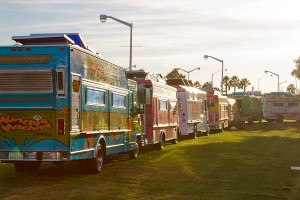Hungry website follows the food trucks
Being the mastermind and moderator of a website might not sound like the coolest job, but it can be if the job is stalking all roaming and upcoming food trucks in the nation’s major cities.
Food trucks have become fast-burgeoning trend in the foodie world ever since the Kogi BBQ truck hit it big by modernizing street food with social networking, and USC alumnus Ross Resnick has made it his business — literally — to keep track of as many of them as possible through his interactive website, Roaming Hunger.
Resnick, who graduated with a degree in international business in 2006, picked Hong Kong as his study abroad destination as a student, and came back well taught — and well fed.
After his semester in Hong Kong, he ate his way through Southeast Asia, spooning up baked pork chop rice in Macau, wolfing down pad thai along the streets of Thailand and chomping on fresh banh mi by the rivers of Vietnam.

Fast food, literally · The Roaming Hunger website follows the now hundreds of food trucks on the road, not just in Los Angeles, but all across the United States, with online guides and reviews of each one. - Photos courtesy of Glen Tagami, Roaming Hunger
By the time he had completed his culinary tour of Cambodia, the Philippines and China, he was smitten with the delicious, local authentic fare that was street food.
But the love was not reciprocated back in Los Angeles, where street food used to be sparse, the communities spread out and the traffic unfriendly to food carts.
Resnick missed the street food in Southeast Asia so much that he found himself frequently visiting the little taco stand that used to stop by Heritage Hall to relive the warm authenticity of street food. When Resnick was introduced to the Green Truck in 2008, he realized that food trucks might fill the void of street food culture in Los Angeles.
“It’s a gourmet meal at a price less than what you’ll find at a restaurant for the same quality of food,” Resnick said. “It’s convenient, it’s fun, it’s fast and people like to do it as an activity. I don’t see any of these factors deteriorating at any time.”
And he was right.
As more and more food trucks started popping up in each street corner of the city, Resnick struggled to keep up with the growing list of food options — which was when his entrepreneurship senses started tingling.
“I thought that ‘hey, this is probably something other people will want too,’” Resnick said. “It could be something big.”
Calling on fellow USC alumnus Morgan Martin, whom Resnick met during his freshman orientation and holds a degree in computer science, the two Trojans worked together to bring Resnick’s inspiration alive.
Six months later in December 2009, Roaming Hunger was launched.
Since then, Roaming Hunger has parked itself as the go-to hub for all things street food. It is the first nationwide food truck tracker offering real-time truck updates and descriptions on each vendor.
Wherever the food truck trend wanders, Roaming Hunger follows. In big cities such as Los Angeles, New York and San Francisco, or smaller areas such as Orange County and Portland, Ore., even north of the border in Vancouver, B.C.; as long as there are people interested in street food, there is work to be done.
With new trucks popping up each day, Roaming Hunger has become a checklist for the vendors. Many vendors now seek out Resnick before they hit the streets, and users are also encouraged to be the website’s eyes and ears. Resnick said that on any given day, about two-to-three new vendors are added to the list nationwide, through notifications by users or the vendors themselves.
Much of the operations on Roaming Hunger are based on user feedback. Roaming Hunger 2.0, launched in August, now alerts a user whenever a truck passes by the vicinity, offers a new truck-booking service for event catering and features a snazzy real-time interactive map with clickable icons to show a truck’s latest tweet.
In a way, Resnick is the ultimate public relations agent for food trucks — one who is actually genuinely passionate and proud about his clients. Each week, he tries to visit at least three vendors — meaning that he has scoured through hundreds of food trucks since he started his business. But even now, Resnick says he is still amazed by how different and unique each vendor is.
“They come in all shapes and sizes and cultures and ages,” he said. “But if there’s one common thread that does unite them, it’s a spirit of entrepreneurship. It is very apparent when you talk to them. This is a group of very hard-working people who produce what they love.”
Resnick not only wants to make food trucks more accessible to the public, he wants to personalize the people behind the trucks as well. The Roaming Hunger blog, for example, is now featuring the “Naanstop Chronicles,” a behind-the-scenes process of starting up an Indian food truck set to launch in early 2011.
Naanstop truck creator Neal Idnani fully reveals the process of starting up a food truck by detailing each snippet of the work, without hiding the freak-outs and frustrations that come with the challenges. Through the series, Resnick gives a human face to these food trucks, and the love that goes behind every bolt of the work.
That can be said for Resnick himself. As a website owner, a majority of his work is spent online, but Resnick says his favorite part of this job is still visiting food trucks, talking to the vendors and eating good food — the all-time favorite street activity that never gets old.
